Chapter: XML and Web Services : XML Content Management and Security
XML Content Management and Security
Semantic
Web:
―The Semantic Web is a major research
initiative of the World Wide Web Consortium
(W3C) to create a metadata-rich Web of
resources that can describe themselves not only by how they should be displayed
(HTML) or syntactically (XML), but also by the meaning of the metadata.‖ – From
W3C Semantic Web Activity Page
―The Semantic Web is an extension of the
current web in which information is given well-defined meaning, better enabling
computers and people to work in cooperation.‖ –Tim Berners-Lee, James Hendler,
Ora Lassila,The Semantic Web, Scientific American, May 2001
Motivations:
Difficulties to find, present, access, or
maintain available electronic information on the
web.
Need for a data representation to enable
software products (agents) to provide intelligent access to heterogeneous and
distributed information.
The Semantic Stack and Ontology Languages:
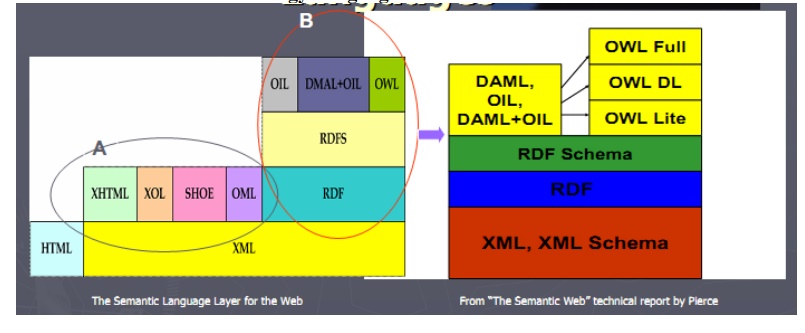
RDF [
Resource Description Framework ]:
Express meaning on the web that machines can
understand.
W3 Specification for Xml code:
<person name=―Jane‖>
<sells product=―books‖/>
</person> Rdf code
<rdf:Description about=―[Jane]‖
xmlns:my=―[my]‖>
<my:sells
rdf:resource=―[books]‖
/>
RDF consists of two parts
– RDF Model (a set of triples)
– RDF Syntax (different XML serialization syntaxes)
RDF Schema for definition of Vocabularies
(simple Ontologies) for RDF (and in RDF)
RDF Data Model:
Resources:
– A resource is a thing you talk about (can
reference)
– Resources have URI‘s
– RDF definitions are itself Resources
(linkage)
Properties:
-
slots,
defines relationship to other resources or atomic values
Statements:
– ―Resource has Property with Value‖
– (Values can be resources or atomic XML data)
-
Similar
to Frame Systems
A simple
Example:
Statement:
– ―Ora Lassila is the creator of the
resource http://www.w3.org/Home/Lassila‖
Structure:
– Resource (subject) http://www.w3.org/Home/Lassila
–Property (predicate) http://www.schema.org/ -
Creator://www.schema.org/#Creator
– Value (object) ―Ora Lassila‖
Directed graph:

Collection Containers:
Multiple occurrences of the same Property Type
doesn‘t establish a relation between the values
– The Millers own a boat, a bike, and a TV set
– The Millers need (a car or a truck)
– (Sarah and Bob) bought a new car
RDF defines three special Resources:
– Bag unordered values rdf:Bag
– Sequence ordered values
rdf:Seq
– Alternative single
value rdf:Alt
• Core RDF does not enforce ‗set‘ semantics amongst values
A Formal
Model of RDF:
RDF itself is mathematically straightforward:
– Basic Definitions
• Resources.
• Properties
ÌResources called
• Literals
• Statements = Resources ´ Properties
X{Resources Èliterals}
– Typing
• rdf:type
Î Properties
• {RDF:type,
sub, obj} Î Statements Þ obj
Î Resources
Formal Model
of RDF II:
Reification
•
rdf:StatementResource-Properties
•
rdf:predicate, rdf:subject,
rdf:objectProperties
•
Reification
of a triplepred, sub, objof Statements
is an element r of Resources representing the
reified triple and the elements s1, s2, s3, and s4 of Statements such that
– s1: {RDF:predicate, r, pred}
– s2: {RDF:subject, r, subj}
– s3: {RDF:object, r, obj}
– s4: {RDF:type, r, [RDF:Statement]}
– Collections
RDF:Seq, RDF:Bag, and RDF:Alt
Resources-Properties
•
There is
a subset of Properties corresponding to the ordinals (1, 2, 3, …) called Ord.
We
refer to
•
elements
of Ord as RDF:_1, RDF:_2, RDF:_3, …
RDF Syntax I:
Data model does not enforce particular syntax
• Specification
suggests many different syntaxes based on XML
General form:
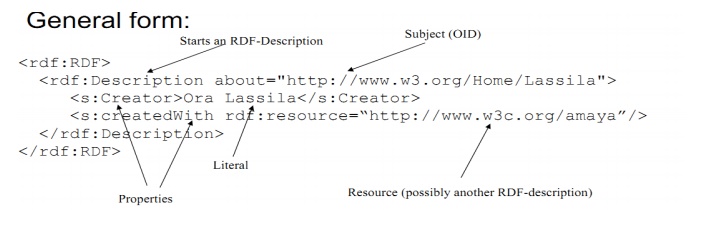
Resulting Graph:
<rdf:RDF>
<rdf:Description
about=‖http://www.w3.org/Home/Lassila‖>
<s:Creator>Ora Lassila</s:Creator>
<s:createdWith
rdf:resource=―http://www.w3c.org/amaya‖/>
</rdf:Description>
</rdf:RDF>
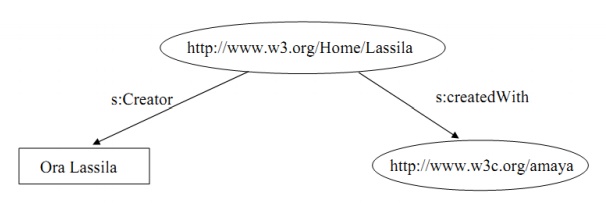
RDF Schema (RDFS):
RDF just defines the data model
•
Need for
definition of vocabularies for the data model – an Ontology Language!
•
RDF
schemas are Web resources (and have URIs) and can be described using RDF
RDF-Schema: Example:
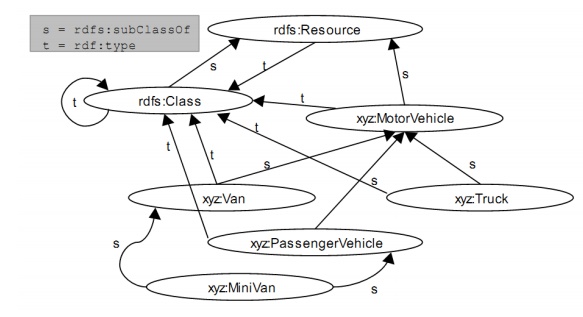
Rdfs: subclass Of:
<rdfs:description about=„Xyz:Minivan―>
<rdfs:subclassOf about=„xyz:Van―/>
</rdfs:description>
<rdfs:description about=„myvan―>
<rdf:type about=„xyz:MiniVan―/>
</rdfs:description>
Predicate
Logic Consequences:
Forall X: type(X,MiniVan) -> type(X,Van).
Forall X: subclassOf(X,MiniVan) -> subclassOf(X,Van).
Rdf:property:
<rdf:description about=„possesses―>
<rdf:type about=„….property―/> <rdfs:domain about=„person―/>
<rdfs:range about=„vehicle―/>
</rdf:description>
<rdf:description about=„peter―>
<possesses>petersminivan</possesses>
</rdf:description>
Predicate
Logic Consequences:
Forall X,Y: possesses (X,Y) ->
(type(X,person) &
type(Y,vehicle)).
Simplification rules:
•
People
specifying text for arbitrary RDF processors can use any simplification
•
Processors
of arbitrary RDF therefore must accept all simplifications
•
Special-purpose
XML formats can be RDF- compliant while disallowing simplifications, requiring
them, or exploiting them in specific ways
Containers vs. Multiple values:
•
A
property can appear more than once with different values
•
What is
true of a container isn‘t necessarily true of its contents and vice versa
•
―aboutEach‖
lets us get to the contents when we already have a container
•
―aboutEachPrefix‖
in effect manufactures a container based on URLs
Reified statements:
•
We reify
statements so that we can talk about them rather than asserting them
•
―Charles
Dickens is the author of Bleak House‖ asserts a property of Charles Dickens
•
―Jack
believes that Charles Dickens is the author of War and Peace‖ asserts a
property of
Jack, not Charles Dickens
RDF Classes:
Are groups of Web resources
•
Have
URLs to identify them
•
The
special class ―rdfs:Literal‖ consists of all possible RDF string values
XLANG:
It is aExchange Language – Web Service for
Business Process Design. Microsoft – runnable on all platforms. It Written
format is XML. It is a Biz Talk Application Designer.
Motivation:
It Enabling technology for new standards and
descriptions around existing technologies => develope language which is able
to handle.
It is a Business imperative to ease the
automation of business processes& to describe a standard for reuse by other
tools.
Relationship
with WSDL:
n
Grounding
of a XLANG service description is defined by using WSDL
n
XLANG
describes the behavior as part of a business process
n
Actions
in XLANG = operations of WSDL
Business
Process (I):
n
Contract
between two ore more parties
n
XLANG
service description describes the behavior
n
It is
used a map – describes the connections between the ports
n
Each
port is added to the map
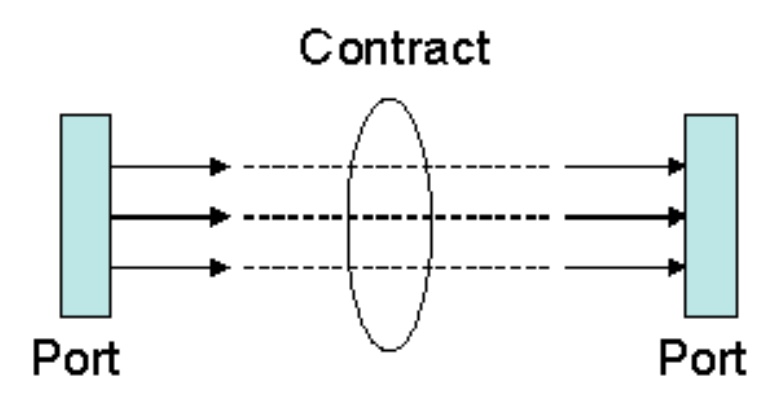
Correlation:
n
Correlation
tokens
n
For
automated instance routing
n
Messages
to the correct port and instance
¨
Instance:
interaction with which the behavior of the service is represented
n
Calculated
lifetime
n
Correlation
set
n
Correlation
group
WSFL:
WSFL describes Web Service compositions. It is a Usage patterns of
Web Services: describes workflow or
business processes. It is a Interaction patterns: describes overall partner interactions.
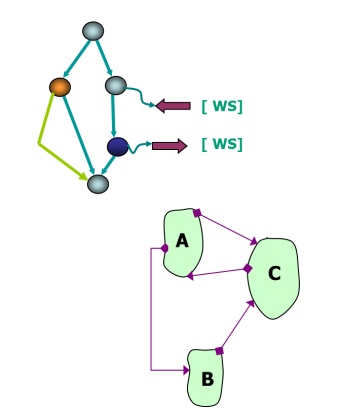
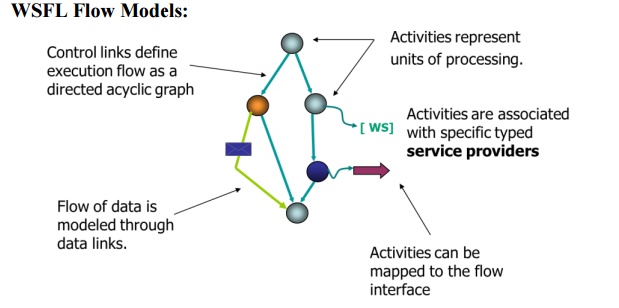
Using
Flow Models:
•
―Public
flows‖ provide a representation of the service behavior as required by its
users.
–
Typically, an abstraction of the actual flow begin executed
–
Defines a ―behavioral contract‖ for the service.
–
Internal implementation need not be flow-based.
– Flows are reusable: specify components types,
but not what specific services should be used!
–
―Private flows‖ are the flows executed in practice.
– WSFL
serves as a ―portable flow implementation language‖
•
Same
language is used in WSFL to represent both types of processes.
Global
Models:
n
Global
models describe how the composed Web Services interact.
n
RosettaNet
automated.
n
Like an
ADL.
n
Interactions
are modeled as links between endpoints of two service interfaces (WSDL
operations).
n
An
essentially distributed description of the interaction.
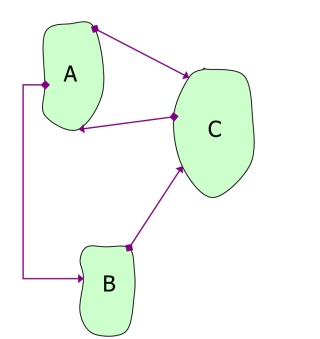
Discovery:
Finding Meta-data:
•
Static
binding requires service ―libraries‖.
•
Dynamic
binding requires runtime discovery of meta-data

Web
Content Management:
•
Every
thing from price list to contact list, home page ,personal info are becoming a
internet content
•
Volume
of content on the internet continuous to grow in size & types of content.
•
Requirements
for Solid web content management solution & dynamic content distribution
Definition:
•
Web
Content Management is generally defined as a combination of clearly defines
roles, formal process and supporting system architecture used to produce,
collaborate on, maintain ,publish & distribute to the web.
Web
Content:
•
Any
information or data on the web
•
We must
identify the types of content we need to manage & how content assets relate
to one another
•
Role to
manage the content
•
Formal
process to manage the workflow based on the roles.
•
Web
Content Management success is investing in information model & Design
Based on the Characteristics of content &
Business model:
–
Straight forward from data base to the web
–
Automated, dynamic generation of a web site
–
Managing text files
– Large
volumes of multimedia based collection
– Newly
created Content
–
Legacy data
Components of Content Management Workflow:
•
Content
– Input phase
– Content Entry
– Content – Repository phase
– Store & Managed
– Content Delivery Phase
– Distributed to web
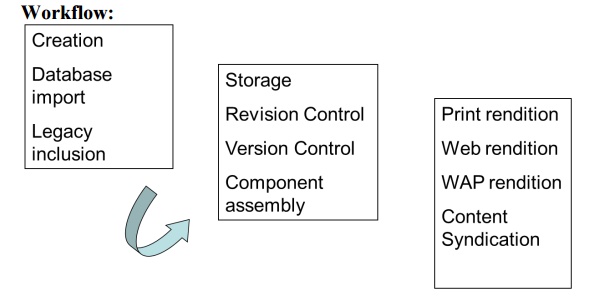
Creation:
•
Created
by the organization & imported into the content management system
•
These
contents can be created in any format-Word, HTML, SGML & XML
•
Through
directly from data base
•
XML is
the standard format
Database
import:
•
Data may
come from the external database within same org or partner organization (ERP)
Legacy
Inclusion
•
Already
Existing data. E.g.: journal
•
In some
other format – Conversion is required
Content
Repository
•
Store
& Management
Storage:
•
Database
– index, relational (or) object oriented
•
Database
can be stored direction (or) pointing to external pointers
•
Importing
is the methodology
Revision
Content – Check in/check out
–
Portion of content can be changed depending on the role
– Roles
are set for each and every author
–
Locking
Version Control
– Complete body of the
content is changed
Content
Assembly
–
Analysis of meta data about each contents & assemble them for final
web delivery
Content
– Delivery phase
•
Common
interface b/w the content & end user must be set
•
XML – is
delivery neutral form
Print
rendition
– Print
media
– XML –
XSL – Content
Web
Rendition
– Web
output (XML – XSL – O/P)
WAP/Mobile
Rendition
–
WAP/WML
Context
Syndication
–
Syndication from single body of content to multiple end users
–
Automate the process
–
Example for web document creation – WAPDav
<?xml version=―1.0‖> <D:acl
xmlns:D:‖DAV‖>
<D:ace>
<D:principal> <D:href>www.xx.com</D:href>
<D:principal>
<D:grant>
<D:privilege>D:read</D:privilege>
<D:privilege>D:write</D:privilege>
</D:grant>
</D:ace>
</D:/acl>
Related Topics